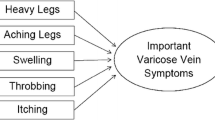Abstract
Background
Patient-reported outcomes are increasingly recognized as important to understanding outcomes of medical interventions such as varicose vein surgery (VVS). Our aim was to compare positive outcomes of VVS as defined by several patient-reported measures, and to identify baseline characteristics associated with positive outcomes of VVS.
Methods
A secondary analysis of the UK Patient-Reported Outcome Measures database was conducted on patients undergoing VVS, in the period 2009–2011 who completed the generic EQ-5D (index and visual analog scale [VAS] summary scores) and disease-specific Aberdeen varicose vein questionnaire (AVVQ). Surgical outcome was defined as positive if pre/post change scores exceeded half a standard deviation of mean baseline scores. Logistic regression models were used to identify significant predictors of positive outcomes, including age, gender, and baseline health.
Results
Of 9,113 patients analyzed (71 % females, 57 % aged >50 years), positive outcomes were identified in 62 % using the AVVQ, 43 % based on EQ-5D index scores, and 24 % according to EQ-VAS; 10 % improved on all three measures. Patients with poorer baseline functioning (AVVQ scores ≥11) were more likely to have a positive outcome based on the EQ-5D index (odds ratio [OR] 1.23, 95 % confidence interval [CI] 1.11–1.36) and EQ-VAS (OR 1.30, 95 % CI 1.14–1.47).
Conclusions
Defining surgery as successful will clearly depend on how health-related quality of life (HRQL) is operationalized and the criteria used to identify meaningful change. Across a range of criteria, a consistently greater proportion of patients had positive outcomes in terms of VV-related functioning (via AVVQ) compared with those who improved in terms of generic health (via EQ-index), or self-rated health (EQ-VAS).


Similar content being viewed by others
References
Beebe-Dimmer JL, Pfeifer JR, Engle JS, Schottenfeld D. The epidemiology of chronic venous insufficiency and varicose veins. Ann Epidemiol. 2005;15(3):175–84.
Moore HM, Lane TR, Thapar A, Franklin IJ, Davies AH. The European burden of primary varicose veins. Phlebology. 2013;28(Suppl 1):141–7.
van den Bremer J, Moll FL. Historical overview of varicose vein surgery. Ann Vasc Surg. 2010;24(3):426–32.
Smith JJ, Garratt AM, Guest M, Greenhalgh RM, Davies AH. Evaluating and improving health-related quality of life in patients with varicose veins. J Vasc Surg. 1999;30(4):710–9.
Lane TR, Sritharan K, Herbert JR, Franklin IJ, Davies AH. Management of chronic venous disease by primary care. Phlebology. 2013;28(6):299–304.
McDaniel MD, Nehler MR, Santilli SM, Hiatt WR, Regensteiner JG, Goldstone J, et al. Extended outcome assessment in the care of vascular diseases: revising the paradigm for the 21st century. Ad Hoc Committee to Study Outcomes Assessment, Society for Vascular Surgery/International Society for Cardiovascular Surgery, North American Chapter. J Vasc Surg. 2000;32(6):1239–50.
Sam RC, MacKenzie RK, Paisley AM, Ruckley CV, Bradbury AW. The effect of superficial venous surgery on generic health-related quality of life. Eur J Vasc Endovasc Surg. 2004;28(3):253–6.
Darvall KA, Sam RC, Bate GR, Silverman SH, Adam DJ, Bradbury AW. Changes in health-related quality of life after ultrasound-guided foam sclerotherapy for great and small saphenous varicose veins. J Vasc Surg. 2010;51(4):913–20.
Rabin R, de Charro F. EQ-5D: a measure of health status from the EuroQol Group. Ann Med. 2001;33(5):337–43.
Finalised Patient Reported Outcome Measures (PROMs) in England—April 2010 to March 2011, Pre- and post-operative data. 2012 [cited 2013 26 April 2013]. Available from: http://www.hscic.gov.uk/catalogue/PUB07049.
Garratt AM, Macdonald LM, Ruta DA, Russell IT, Buckingham JK, Krukowski ZH. Towards measurement of outcome for patients with varicose veins. Qual Health Care. 1993;2(1):5–10.
Garratt AM, Ruta DA, Abdalla MI, Russell IT. Responsiveness of the SF-36 and a condition-specific measure of health for patients with varicose veins. Qual Life Res. 1996;5(2):223–34.
Nesbitt C, Wilson WR, Lees TA, Stansby G. Interpretation of patient-reported outcome measures for varicose vein surgery. Phlebology. 2012;27(4):173–8.
Brooks R. EuroQol: the current state of play. Health Policy. 1996;37(1):53–72.
Dolan P. Modeling valuations for EuroQol health states. Med Care. 1997;35(11):1095–108.
Revicki DA, Cella D, Hays RD, Sloan JA, Lenderking WR, Aaronson NK. Responsiveness and minimal important differences for patient reported outcomes. Health Qual Life Outcomes. 2006;4:70.
Pickard AS, Neary MP, Cella D. Estimation of minimally important differences in EQ-5D utility and VAS scores in cancer. Health Qual Life Outcomes. 2007;5:70.
Klem TM, Sybrandy JE, Wittens CH. Measurement of health-related quality of life with the Dutch translated Aberdeen Varicose Vein Questionnaire before and after treatment. Eur J Vasc Endovasc Surg. 2009;37(4):470–6.
National Institute for Health and Clinical Excellence. Varicose veins in the legs [cited 2014 10 July]. Available from: http://www.nice.org.uk/guidance/CG168.
Health Information and Quality Authority. Health Technology Assessment of Scheduled Surgical Procedures [cited 2014 5 July]. Available from: http://irishpatients.ie/news/wp-content/uploads/2013/04/HTA-Varicose-Vein-April-131.pdf.
Berridge D, Bradbury AW, Davies AH, Gohel M, Nyamekye I, Renton S, et al. Recommendations for the referral and treatment of patients with lower limb chronic venous insufficiency (including varicose veins). Phlebology. 2011;26(3):91–3.
Burton KE, Wright V, Richards J. Patients’ expectations in relation to outcome of total hip replacement surgery. Ann Rheum Dis. 1979;38(5):471–4.
Hopman WM, Mantle M, Towheed TE, MacKenzie TA. Determinants of health-related quality of life following elective total hip replacement. Am J Med Qual. 1999;14(3):110–6.
Zweig T, Aghayev E, Melloh M, Dietrich D, Roder C. Influence of preoperative leg pain and radiculopathy on outcomes in mono-segmental lumbar total disc replacement: results from a nationwide registry. Eur Spine J. 2012;21(Suppl 6):S729–36.
Lattimer CR, Kalodiki E, Azzam M, Geroulakos G. The Aberdeen varicose vein questionnaire may be the preferred method of rationing patients for varicose vein surgery. Angiology. 2014;65(3):205–9.
Ethgen O, Bruyere O, Richy F, Dardennes C, Reginster JY. Health-related quality of life in total hip and total knee arthroplasty. A qualitative and systematic review of the literature. J Bone Joint Surg Am. 2004;86-A(5):963–74.
Rolfson O, Dahlberg LE, Nilsson JA, Malchau H, Garellick G. Variables determining outcome in total hip replacement surgery. J Bone Joint Surg Br. 2009;91(2):157–61.
Bilberg R, Norgaard B, Overgaard S, Roessler KK. Patient anxiety and concern as predictors for the perceived quality of treatment and patient reported outcome (PRO) in orthopaedic surgery. BMC Health Serv Res. 2012;12:244.
Devlin NJ, Appleby J. Getting the most out of proms: putting health outcomes at the heart of NHS decision-making. London: The King’s Fund, Office of Health Economics; 2010.
Kurz X, Lamping DL, Kahn SR, Baccaglini U, Zuccarelli F, Spreafico G, et al. Do varicose veins affect quality of life? Results of an international population-based study. J Vasc Surg. 2001;34(4):641–8.
Samuel N, Wallace T, Carradice D, Smith G, Mazari F, Chetter I. Evolution of an endovenous laser ablation practice for varicose veins. Phlebology. 2013;28(5):248–56.
Hutchings A, Grosse Frie K, Neuburger J, van der Meulen J, Black N. Late response to patient-reported outcome questionnaires after surgery was associated with worse outcome. J Clin Epidemiol. 2013;66(2):218–25.
Norman GR, Sloan JA, Wyrwich KW. Interpretation of changes in health-related quality of life: the remarkable universality of half a standard deviation. Med Care. 2003;41(5):582–92.
Walters SJ, Brazier JE. Comparison of the minimally important difference for two health state utility measures: EQ-5D and SF-6D. Qual Life Res. 2005;14(6):1523–32.
Cheung YT, Foo YL, Shwe M, Tan YP, Fan G, Yong WS, et al. Minimal clinically important difference (MCID) for the functional assessment of cancer therapy: cognitive function (FACT-Cog) in breast cancer patients. J Clin Epidemiol. 2014;67(7):811–20.
Farivar SS, Liu H, Hays RD. Half standard deviation estimate of the minimally important difference in HRQOL scores? Expert Rev Pharmacoecon Outcomes Res. 2004;4(5):515–23.
Hays RD, Brodsky M, Johnston MF, Spritzer KL, Hui KK. Evaluating the statistical significance of health-related quality-of-life change in individual patients. Eval Health Prof. 2005;28(2):160–71.
Acknowledgments
All authors contributed to the conceptualization of the study. WHC, HP, WJL, and FJL conducted the analysis. All authors were responsible for interpretation of the results. WHC and ASP drafted the manuscript, and all authors edited and approved of the final version.
Disclosures
Haridarshan Patel was supported by a fellowship funded by Takeda Pharmaceuticals. This research received no specific grant from any funding agency in the public, commercial, or not-for-profit sectors.
Author information
Authors and Affiliations
Corresponding author
Electronic supplementary material
Below is the link to the electronic supplementary material.
Rights and permissions
About this article
Cite this article
Cheng, WH., Patel, H., Lee, WJ. et al. Positive Outcomes of Varicose Vein Surgery: The Patient Perspective. Patient 8, 329–337 (2015). https://doi.org/10.1007/s40271-014-0092-x
Published:
Issue Date:
DOI: https://doi.org/10.1007/s40271-014-0092-x




